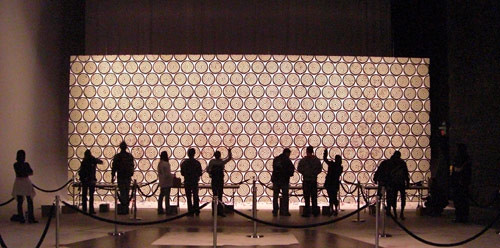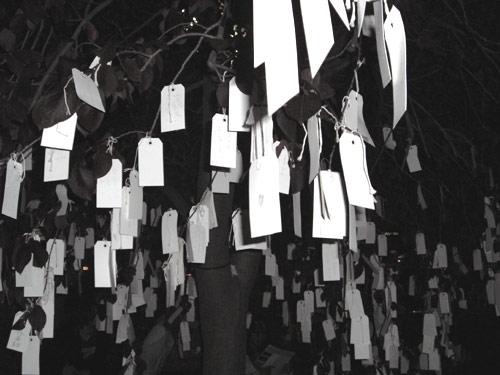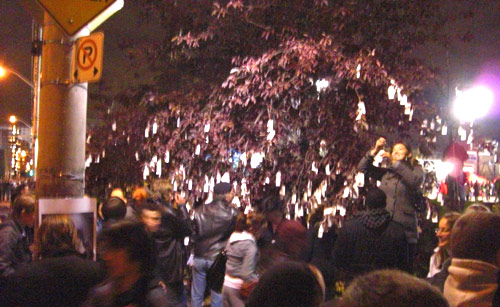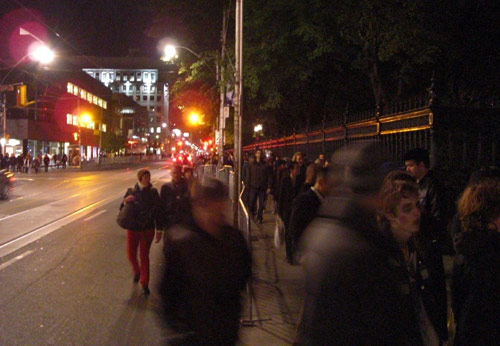
Words on steel drums (Euphemisms for the intimate enemy, Ruark Lewis), Liberty Village
For Nuit Blanche this year, I focused on Liberty Village (“Zone C”). This year’s format, which was more focused both in terms of geography and the choice of artworks, seemed to me to be an improvement over last year. The smaller number of works, more consciously curated, seemed to result in large and/or interactive projects that worked well on the public scale of the night.

Huge dartboard (I, the world, things, life by Jacob Dahlgren), Liberty Village
The projects themselves also seemed to be better executed than last year, when some of them seemed kind of (please pardon the term) half-assed. Even ones this year that sounded pretty basic when described (e.g. “SMASH! Dropping stuff” — which is pretty much self-explanatory) often turned out to be more complex and fully-realized when you actually saw them. And it was easier to see a larger number of the major works because they were all in reasonably focused geographic areas.
Yoko Ono’s Imagine Peace, where people wrote their wishes on tags and hung them from trees, was another project that sounded pretty simple but actually worked out to be quite beautiful.


After Liberty Village, I cycled downtown (“Zone A”) to enjoy Stereoscope by Project Blinkenlights, where they turned City Hall into a huge interactive pixel screen — including a massive live game of Pong (people could dial in to join a game, and control the paddles with their cellphones).

What I didn’t know is that they would also open up the City Hall gangway, podium level and walkway (you can faintly see people walking up the gangway in the photo above). It was cool to finally see this part of City Hall. A closer look at the back made me appreciate the details of the architecture a lot more — the concrete is really finely decorated — and it created some interesting views.
It made me wonder why these parts of the City Hall building are not open all the time. I had thought it was because they weren’t properly maintained, but obviously they were safe enough for Nuit Blanche. They would make an appealing addition to the public space of City Hall.
The wonderful thing about Nuit Blanche is just how many people are out on the streets walking around. It is like a brief glimpse of a potential ideal of urban vibrancy. Given that it’s one of the biggest pedestrian events of the year, what remains particularly baffling is how little the streets are closed to private motor vehicles (there were a couple of blocks closed off in Liberty Village, where there is little vehicle traffic anyway, but not a lot). After all, they close off main streets for an entire day for massive pedestrian events like Taste of the Danforth. Pedestrians in Nuit Blanche are literally spilling off the sidewalks, which are not large enough to accommodate their numbers. Why not close off to private vehicles the roads that are most heavily used, leaving just space for transit and bikes? Only a tiny fraction of the people on the street are moving by car.
The most absurd situation was on Queen West in front of Osgoode Hall, right beside City Hall, where the city put up barriers along the narrow sidewalk to keep the tens of thousands of people travelling there during the night from spilling out onto the road and disturbing the few hundred people driving by there in a car. Probably the idea was to prevent cars from blocking the streetcar — but why not just keep cars out of this stretch completely, and temporarily widen the sidewalk by putting these barriers in the midst of the right lane (leaving just enough space for bikes)?

It’s great to see the way pedestrians rule the streets of downtown Toronto for at least this one night of the year.



8 comments
It’s ridiculous that they don’t close off major portions of all streets in the “Zones”. Last year’s Nuit Blanche was a wash because you couldn’t physically move down Queen Street West by driving, walking, cycling, transit, or anything. It was total gridlock. Shocking and appalling.
I was amazed that the organizers overlooked the most simple of factors: getting to the exhibits. Get the cars out, there’s no need for them on this night!
They closed off huge portions of the entire downtown last weekend for 10 hours for a Marathon of 13,000 people or so.
Then for Nuit Blanche where they are expecting *800,000* people to wander the streets for 12 hours and they made no changes to traffic at all.
Who’s running this thing?
There were other closings — Church Street was closed, Parliament was closed. Places on the periphery of certain zones, but not where the crush was.
And Queen West West was still nearly impassible this year, with all the pedestrians and the occasional stretcher responding to vomit duty.
Rich people run in marathons, I only saw regular folk wandering Nuit Blanche – mostly student-aged and with a strong pong of pot. I like that demographic fine, and ride bikes along with them, but those who run the city don’t give a …
Dare I risk an observation that Nuit Blanche is a good example of what cities, dense, walkable, curious, frustrating, surprising, loveable for all their faults are about?
You have to go a long way to find a better example of how the built form of old Toronto allows this sort of event to happen. The narrow streets. The small buildings. The absence of parking lots. The blurred line between private and public spaces. The sense of the city as a playground to be explored.
Oh are you ever right about those crowd control barriers, Dylan. The walk from the City Hall to the Osgoode Station was the most claustrophobic and infuriating 20 minutes of my year (it beats last year’s trying to get home in a packed stuffy subway car around 12:30 am at Nuit Blanche 2007).
The City Hall walkways are also usually opened up during Doors Open. In daylight, it’s clear they’re not in the best shape, but they’re definitely usable. And they have the best vantage points for pics of New and Old City Hall.